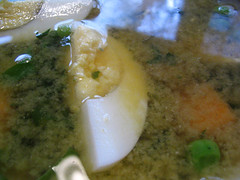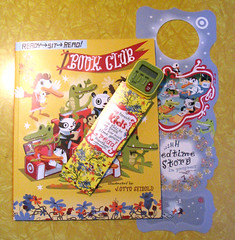
Yup! Soup for breakfast!! Most days now, Emily and I have a miso soup breakfast or brunch (okay, a lot of the time my breakfast is tea while she has oatmeal, then we have this 2-3 hours later). And it's actually probably the best thing I've found to eat first thing in the day.
I always was fascinated by the idea of the traditional Japanese breakfast after seeing it in enough TV shows -- I'm not so sure about the fish, but soup and rice sounded pretty good to me. I've never been into the whole sweet breakfast paradigm and while the eggs and meat thing works for me, it's heavy and a pain to cook. I always meant to try it but never did, but I've been trying to be more diligent about actually eating breakfast every day.
And finally I got motivated to try it out, after reading
Japanese Women Don't Get Old or Fat
(*see more on this book below) and seeing her "Japanese Power Breakfast" idea (basically, miso for breakfast). I didn't even really look at her recipe, since I knew how to make miso soup just fine. But I did use her idea of adding a quartered hard-boiled egg, and her list of vegetables to use made me feel better about adding whatever I had sitting around.
want to make your own?
So here are the basics (feel free to improvise, especially if you have a favorite method for making miso soup):
You will be doing two things at once (can you handle it?)
Start by putting 8-12 ounces of water in a small saucepan (I use 12oz because I'm sharing with the baby!), and at this point add any raw hard vegetable you may have (sliced carrots, daikon, etc) so they cook evenly. (At this point I also add any frozen puree.) Bring water to a boil, and add your
dashi powder
. Stir to dissolve. Add soft foods like tofu now, and then add your
miso paste
.
While your water is heating, in a microwave-safe bowl, put whatever frozen and/or leftover vegetables you've got and heat for 1-2 minutes in the microwave. Top veggie mixture with a quartered hard-boiled egg.
Now to combine! Pour your miso soup over the veggies and egg. Tada! Breakfast! Protein-rich, super-fast, and low, low-fat. (Let's not bring up the sodium, shall we?)
Ingredient ideas - the soup I took the photo of had peas, spinach, daikon, diced sweet potato (leftover, not raw) and a big spoonful of kabocha puree in the bottom of the bowl; I added tofu and some negi (use leeks or scallions, although leeks are probably closer) to the miso. Today my broth had pureed butternut squash and carrots added, and my veggies included edamame, corn and a little spinach for color. I can't really imagine anything that wouldn't work -- in the book, she talks about using cold cherry tomatoes, and while I can't personally imagine doing that, they obviously think it works just fine.
Speaking of the book...I got it from the library on a whim last month. I got the feeling that it was a book that had been long in the making, and got slapped with the unfortunate title because of
French Women Don't Get Fat selling so many copies. It's a very nice introduction to Japanese cooking and food culture, but if you are at all familiar with Japanese cooking it's not going to break any ground for you. The weirdest thing for me was getting to some of the recipes and discovering that they were basic dishes with new names - her "Iri Iri Pan Pan" is called "tri-color donburi" in at least 2 cookbooks I have, for example. But there's some good info, and if you're interested in Japanese cooking I would recommend it as a library read. It's not really something you're going to need to keep referring to, I don't think.






